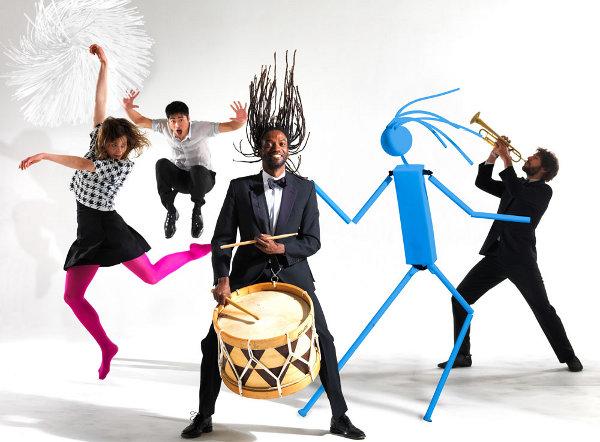As we enter the depressingly empty Silk Street Theatre auditorium, we look to the stage to see a kind of giant π (Pi) shape made of blue neon lights, and to the side a small drumkit. At five minutes before the start of the show, the theatre is less than a quarter full – although to be fair to the company, this is the second show of the day and perhaps 7pm is not the ideal time for a family show. I check in with an usher, who says that the afternoon shows during the run have been very well attended for the most part…
It feels a little cold and gloomy sitting here under the blue neon, surrounded by empty seats, but there’s a last-minute rush of punters – and of performers, who enter in a flurry of pink tutus, green skirts, mauve shirts, and red leggings, and take their place amongst the audience. Now a burst of sound, and one by one the performers are summonsed on stage by the call of the drum – a tambourine played with extraordinary skill and verve by beat-boxer, percussionist and all-round hugely talented musician Adriano Adewale. Each performer creates their own idiosyncratic dance (or in the case of the second musician, Leo Altarelli, sound motif) as they ‘play’ to their shaman/conductor, and to the audience, before sashaying through, or limbo-dancing under, a morphing neon light ‘door’.
It’s a great start, and the follow-up is equally good, as a series of abstract shapes appear in the dark, puppeteered by invisible performers. After much clever shape-shifting, a puppet baby emerges, to be held and cooed over by her eight-strong team of parent-carers. Toddlerhood is played out through such wonderful scenes as a dance on a glockenspiel, the puppet’s little wooden feet serving as hammers tapping out the tune. Early childhood sees a very lovely little human-and-puppet tap dance, and a charming (if a little overlong) magic-tricks-and-transformations scene featuring a series of peony pink and lime green cones and balls.
Meanwhile the neon frame opens out to reveal a frame within the frame, shifting colours (from blue to white to yellow to pink…) in a Messiaen-like synaesthetic response to the notes played by our two highly gifted multi-instrumentalists, who move easily from trumpet to uke to drumkit and back to glockenspiel (via a bit of body percussion and the occasional tune on a kazoo).
With the advent of adolescence comes attitude: electric guitar, mini-skirts, tossed hair, and the donning of shades. And it’s downhill from then on in, as the child-carer relationship cracks, and the show itself shows signs of strain…
Theatre-Rites director Sue Buckmaster has declared her intention for Mojo(her second collaboration with choreographer Arthur Pita, following Mischief) to ‘explore the ways in which our society both ignites and hinders our children’s energy and spirit’, but it seems such a shame that all the ‘igniting’ seems to happen in early childhood, and the teenage section is a clichéd exploration of the ‘hindering’. There’s lots of finger-wagging and foot-stamping – and a mysterious long-winded section in which our puppet girl disappears for ages and the carers left behind wrestle with a giant spider upon a stage revolve (which is in itself a rather unnecessary piece of kit that adds little to the production).
What can it all mean? That they are experiencing the ‘we’ve lost our little girl’ feeling many parents experience in the teenage years? Could the spider be a metaphorical representation of burgeoning female sexuality? But hang on a mo – this a show aimed at families with children aged five and upwards. Such themes would not be of any interest to young children. Who on earth can this section of the show be aimed at, then?
This is a major dramaturgical hitch. The Play-Away vibe of the first half is delightfully innocent and appeals equally to adults and to young children, but is too ‘childish’ in tone for teenagers or pre-teenagers. The subject matter for the second half is too grown-up for young children – yet on the other hand, older children and teenagers hate being ‘discussed’ onstage in this knowing way, so I feel it wouldn’t appeal to them either.
Eventually our puppet girl re-emerges to shake off her teenage angst and grasp the world of young womanhood. This is played out through a samba-carnival routine in which the music and dance is wonderfully exuberant – but the puppetry suddenly becomes the least important consideration, with our almost-grown girl left with a dead and dangling arm, and a strange twitching dance action, whilst the human dancers give it all they’ve got alongside her. This in odd contrast to the excellent puppetry of the earlier sections. Work to be done here, then!
Despite these reservations, a production to be applauded for its extraordinary and inspiring fusion of live music and puppetry – it is rare to see a work in which live animation and sound work so closely in harmony.


